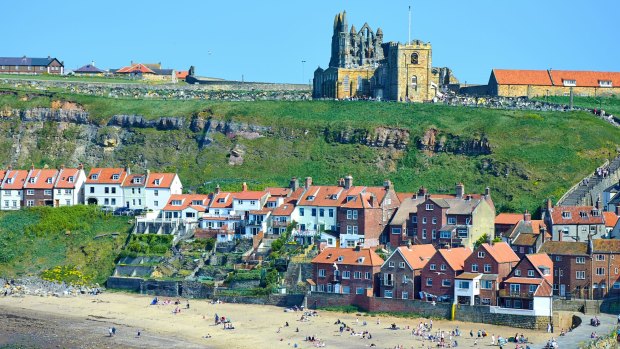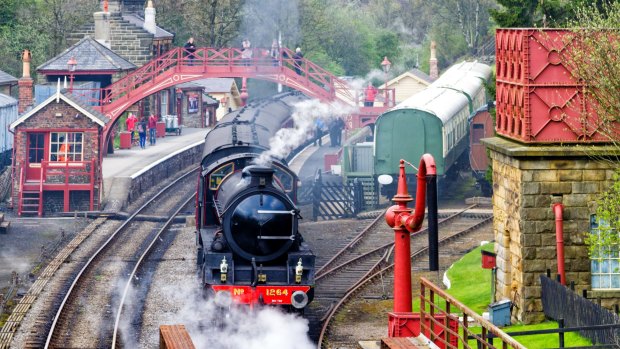This was published 5 years ago
North Yorkshire Moors Railway, England: A steam-train ride through pop culture history
By Steve McKenna

Whitby in North Yorkshire, England, is a terrific place for a wander, with atmospheric, winding streets and salty-aired clifftop vistas. Credit: Shutterstock
Carefully, ever so slowly, I nudge my head out of the open window of our carriage and see a glorious sight ahead: plumes of smoke billowing from the chimney of the vintage locomotive as it pulls us through the pastoral landscapes of the North York Moors National Park. It's 50 years since Britain's last regular steam train service ended, but thanks to the endeavours of not-for-profit preservation societies and railway-loving volunteers, special heritage rides still choo-choo across the country. And few are more heart-fluttering than this, the North Yorkshire Moors Railway, which chugs 29 kilometres over "God's Own Country" – as Yorkshire folk call their beloved neck of the woods.
From April to November – and on selected dates during the northern-hemisphere winter – trains run hourly every day between the picturesque market town of Pickering and the old whaling port and coastal resort of Whitby, where, in the mid-18th century, a young sailor, James Cook, learned the ropes, and, later, Bram Stoker came on holiday and found the inspiration for Dracula. A return ticket lets you travel between Pickering and Whitby and hop-on, hop-off at the other four stops along a line that was originally launched in 1836, closed by the government in 1965 for being uneconomic, and reopened by a charitable trust in 1973. The stations, especially Pickering's, are beautifully-kept, adorned with pretty floral displays and restored period decor, with signage, bridges, luggage chest-trunks and trolleys, ticket offices and news-stands harking back to Victorian, Edwardian and interwar times.

A vintage passenger steam train leaves Goathland Station on the way to Whitby on the North Yorkshire Moors Railway.
Trains are mostly steam-hauled – ours is a shiny black 1930s-era Repton locomotive – although on some journeys heritage diesel units are used. The carriages have a similarly bygone feel, with wood-panelling and velvety upholstered seating that gently rocks up and down as the train clickety-clacks along. While standard class has an open lay-out, first class has snug, shut-off booths seating six to eight people. Retro-uniformed ticket inspectors and staff selling souvenir programmes and refreshments do the rounds. It would be rude, we feel, not to order some Yorkshire Tea and as we sip on our brew, we take in the window views: a rolling patchwork of rugged heather moorland, verdant forest plantations, fields of dry-stone walls and grazing cattle and the snaking River Esk, which empties into the North Sea at Whitby.
Like many passengers, we break our journey at Goathland. Youngsters – and the young-at-heart – may recognise the station as Hogsmeade's from the first Harry Potter movie (the Hogwarts Express steamed through on this very track). Older passengers may know Goathland as Aidensfield from the classic British TV hit, Heartbeat (set in the 1960s, it ran from 1992 to 2010). With the show's catchy Buddy Holly-inspired theme tune ("Heartbeat, why do you miss when my baby kisses me...") in my head, we stroll up into the tiny centre of Goathland, where sheep are pottering about on the village green and set-locations and parked vehicles from Heartbeat, like Aidensfield village store and the Ford Anglia police car, delight fans.
After re-boarding the next train at Goathland, we close in on Whitby, passing under the Larpool Viaduct – a 13-arch Victorian marvel boasting about 5 million bricks. Bram Stoker mentioned it in his 1897 story, Dracula – in which the count's ship runs aground in Whitby – and we can glimpse, in the distance, the eerie hilltop ruins of Whitby Abbey (where Dracula, the play, is performed on summer evenings). Boasting a near-permanent soundtrack of squawking gulls, Whitby is a terrific place for a wander, with atmospheric, winding streets, salty-aired clifftop vistas and myriad Captain Cook connections. In the harbour, near the railway station, you'll find a replica of Endeavour – the Whitby-built vessel that brought Cook Down Under. Unveiled here for the 250th anniversary of his first Pacific expedition, it doubles as a floating museum-cum-pleasure boat, offering cruises along North Yorkshire's beautiful coastline replete with tales of Cook's enthralling adventures.
Trip Notes
Steve McKenna travelled at his own expense.
Return/day tickets on the North Yorkshire Moors Railway are priced £31 ($55) for adults; £15.50 for children. A family of four can travel for £64. See nymr.co.uk
Sign up for the Traveller Deals newsletter
Get exclusive travel deals delivered straight to your inbox. Sign up now.